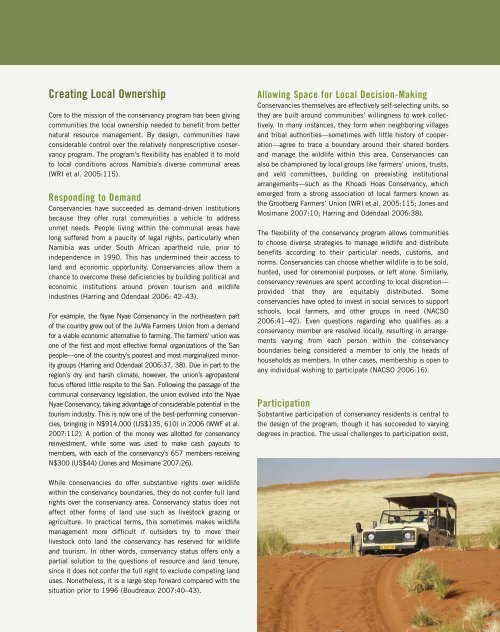Growing the Wealth of the Poor - World Resources Institute
Growing the Wealth of the Poor - World Resources Institute
Growing the Wealth of the Poor - World Resources Institute
You also want an ePaper? Increase the reach of your titles
YUMPU automatically turns print PDFs into web optimized ePapers that Google loves.
Creating Local OwnershipCore to <strong>the</strong> mission <strong>of</strong> <strong>the</strong> conservancy program has been givingcommunities <strong>the</strong> local ownership needed to benefit from betternatural resource management. By design, communities haveconsiderable control over <strong>the</strong> relatively nonprescriptive conservancyprogram. The program’s flexibility has enabled it to moldto local conditions across Namibia’s diverse communal areas(WRI et al. 2005:115).Responding to DemandConservancies have succeeded as demand-driven institutionsbecause <strong>the</strong>y <strong>of</strong>fer rural communities a vehicle to addressunmet needs. People living within <strong>the</strong> communal areas havelong suffered from a paucity <strong>of</strong> legal rights, particularly whenNamibia was under South African apar<strong>the</strong>id rule, prior toindependence in 1990. This has undermined <strong>the</strong>ir access toland and economic opportunity. Conservancies allow <strong>the</strong>m achance to overcome <strong>the</strong>se deficiencies by building political andeconomic institutions around proven tourism and wildlifeindustries (Harring and Odendaal 2006: 42–43).For example, <strong>the</strong> Nyae Nyae Conservancy in <strong>the</strong> nor<strong>the</strong>astern part<strong>of</strong> <strong>the</strong> country grew out <strong>of</strong> <strong>the</strong> Ju/Wa Farmers Union from a demandfor a viable economic alternative to farming. The farmers’ union wasone <strong>of</strong> <strong>the</strong> first and most effective formal organizations <strong>of</strong> <strong>the</strong> Sanpeople—one <strong>of</strong> <strong>the</strong> country’s poorest and most marginalized minoritygroups (Harring and Odendaal 2006:37, 38). Due in part to <strong>the</strong>region’s dry and harsh climate, however, <strong>the</strong> union’s agropastoralfocus <strong>of</strong>fered little respite to <strong>the</strong> San. Following <strong>the</strong> passage <strong>of</strong> <strong>the</strong>communal conservancy legislation, <strong>the</strong> union evolved into <strong>the</strong> NyaeNyae Conservancy, taking advantage <strong>of</strong> considerable potential in <strong>the</strong>tourism industry. This is now one <strong>of</strong> <strong>the</strong> best-performing conservancies,bringing in N$914,000 (US$135, 610) in 2006 (WWF et al.2007:112). A portion <strong>of</strong> <strong>the</strong> money was allotted for conservancyreinvestment, while some was used to make cash payouts tomembers, with each <strong>of</strong> <strong>the</strong> conservancy’s 657 members receivingN$300 (US$44) (Jones and Mosimane 2007:26).Allowing Space for Local Decision-MakingConservancies <strong>the</strong>mselves are effectively self-selecting units, so<strong>the</strong>y are built around communities’ willingness to work collectively.In many instances, <strong>the</strong>y form when neighboring villagesand tribal authorities—sometimes with little history <strong>of</strong> cooperation—agreeto trace a boundary around <strong>the</strong>ir shared bordersand manage <strong>the</strong> wildlife within this area. Conservancies canalso be championed by local groups like farmers’ unions, trusts,and veld committees, building on preexisting institutionalarrangements—such as <strong>the</strong> Khoadi Hoas Conservancy, whichemerged from a strong association <strong>of</strong> local farmers known as<strong>the</strong> Grootberg Farmers’ Union (WRI et al. 2005:115; Jones andMosimane 2007:10; Harring and Odendaal 2006:38).The flexibility <strong>of</strong> <strong>the</strong> conservancy program allows communitiesto choose diverse strategies to manage wildlife and distributebenefits according to <strong>the</strong>ir particular needs, customs, andnorms. Conservancies can choose whe<strong>the</strong>r wildlife is to be sold,hunted, used for ceremonial purposes, or left alone. Similarly,conservancy revenues are spent according to local discretion—provided that <strong>the</strong>y are equitably distributed. Someconservancies have opted to invest in social services to supportschools, local farmers, and o<strong>the</strong>r groups in need (NACSO2006:41–42). Even questions regarding who qualifies as aconservancy member are resolved locally, resulting in arrangementsvarying from each person within <strong>the</strong> conservancyboundaries being considered a member to only <strong>the</strong> heads <strong>of</strong>households as members. In o<strong>the</strong>r cases, membership is open toany individual wishing to participate (NACSO 2006:16).ParticipationSubstantive participation <strong>of</strong> conservancy residents is central to<strong>the</strong> design <strong>of</strong> <strong>the</strong> program, though it has succeeded to varyingdegrees in practice. The usual challenges to participation exist,While conservancies do <strong>of</strong>fer substantive rights over wildlifewithin <strong>the</strong> conservancy boundaries, <strong>the</strong>y do not confer full landrights over <strong>the</strong> conservancy area. Conservancy status does notaffect o<strong>the</strong>r forms <strong>of</strong> land use such as livestock grazing oragriculture. In practical terms, this sometimes makes wildlifemanagement more difficult if outsiders try to move <strong>the</strong>irlivestock onto land <strong>the</strong> conservancy has reserved for wildlifeand tourism. In o<strong>the</strong>r words, conservancy status <strong>of</strong>fers only apartial solution to <strong>the</strong> questions <strong>of</strong> resource and land tenure,since it does not confer <strong>the</strong> full right to exclude competing landuses. None<strong>the</strong>less, it is a large step forward compared with <strong>the</strong>situation prior to 1996 (Boudreaux 2007:40–43).
















